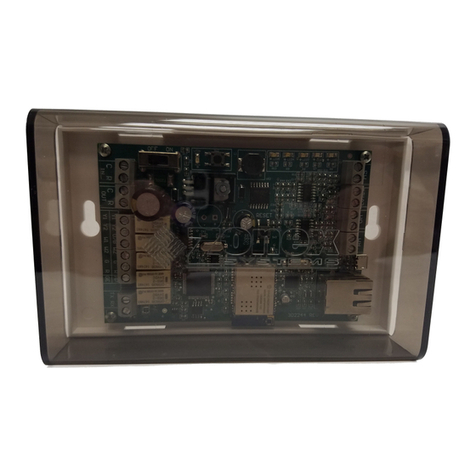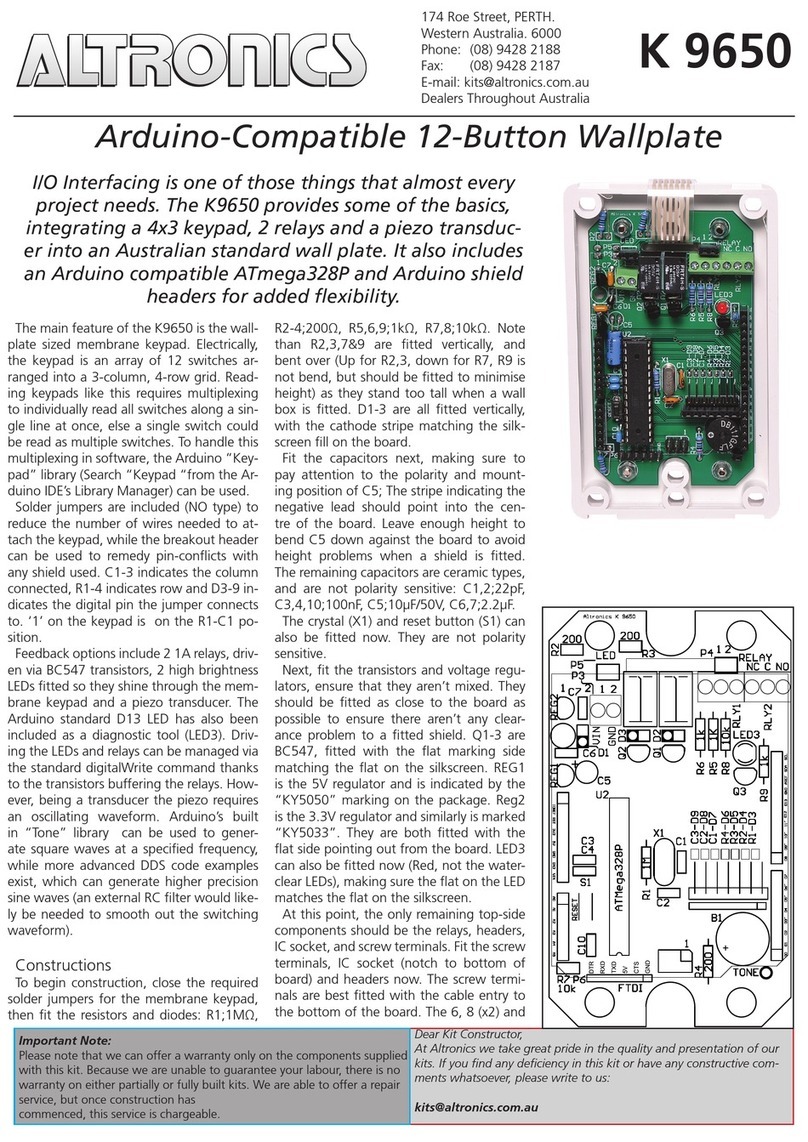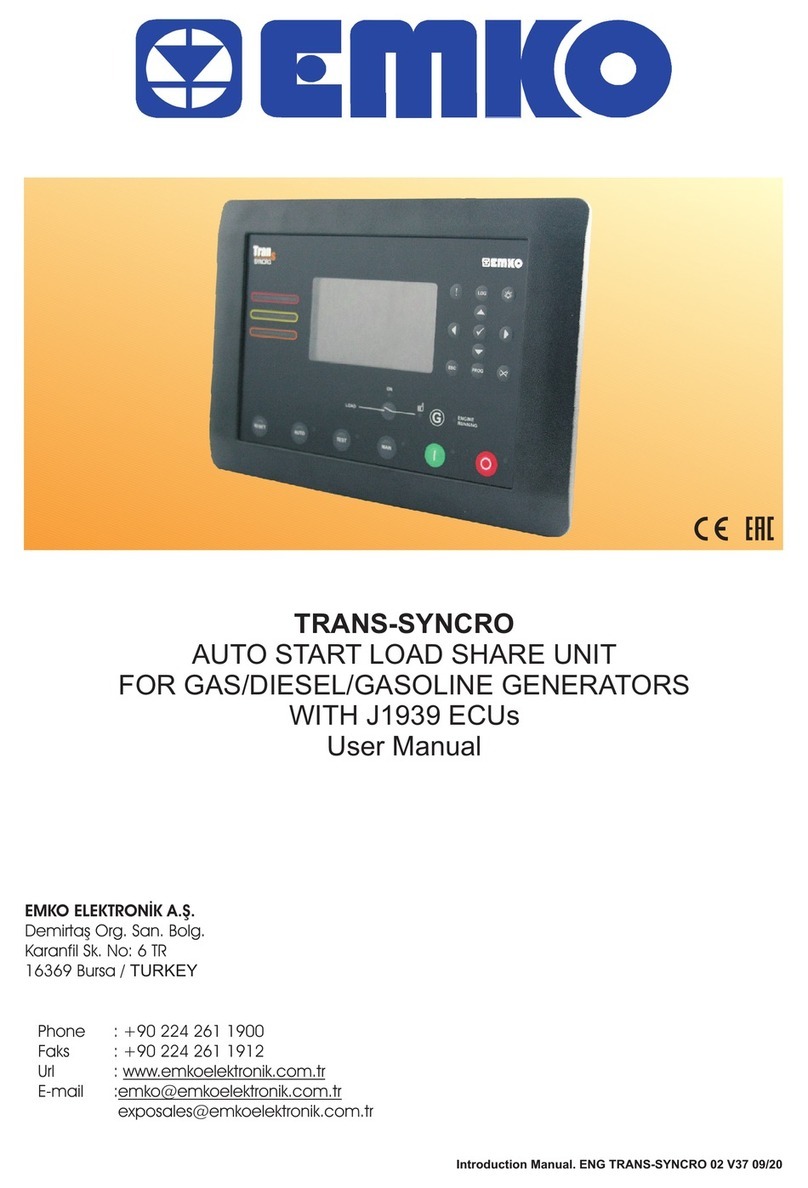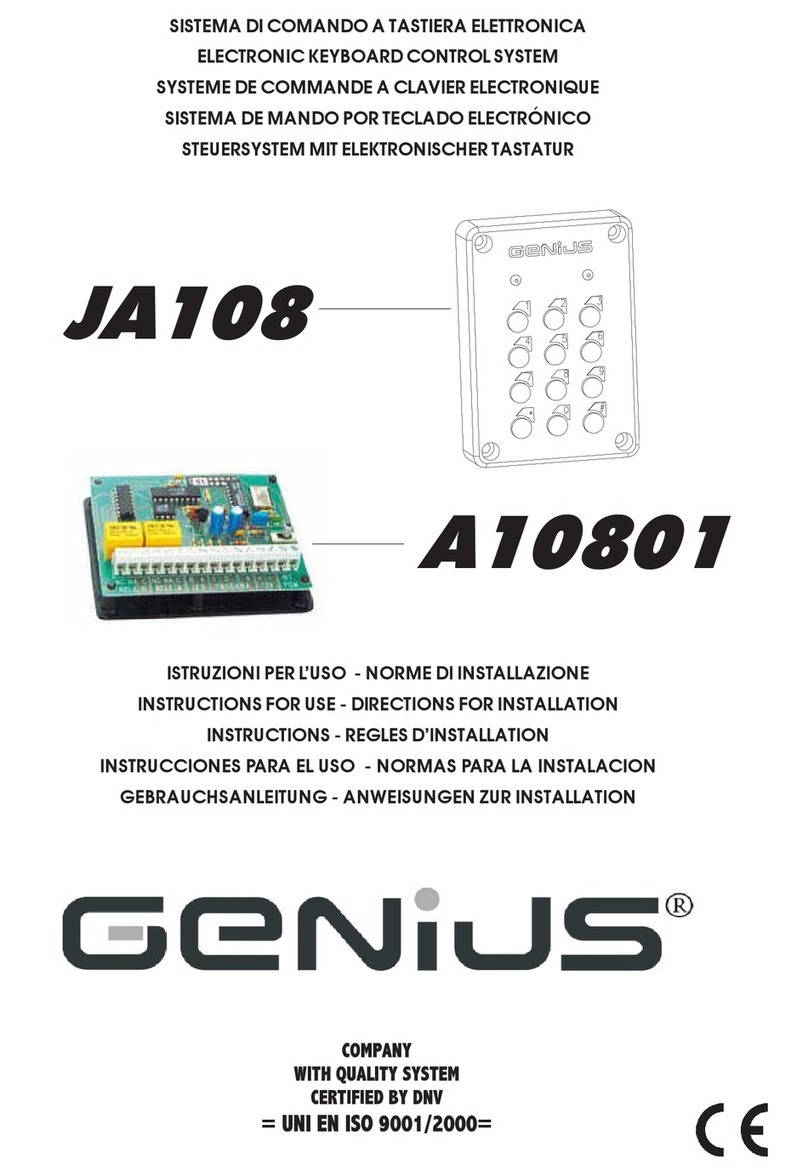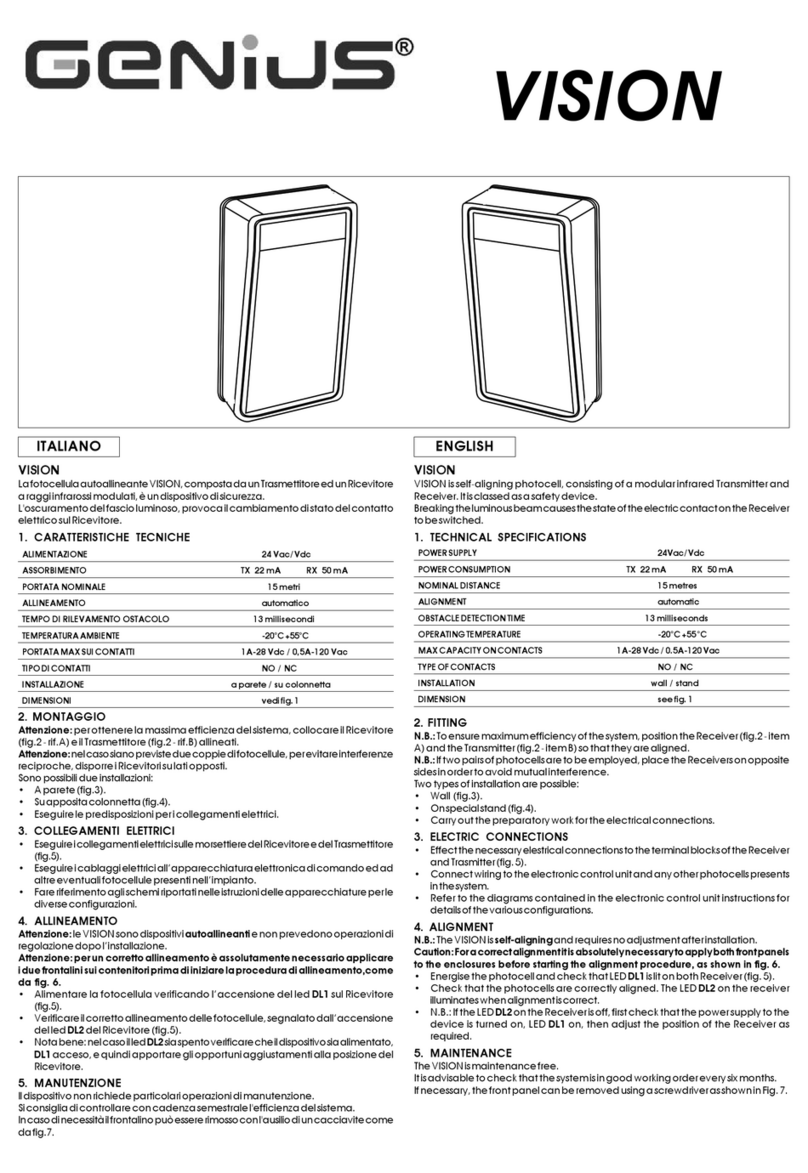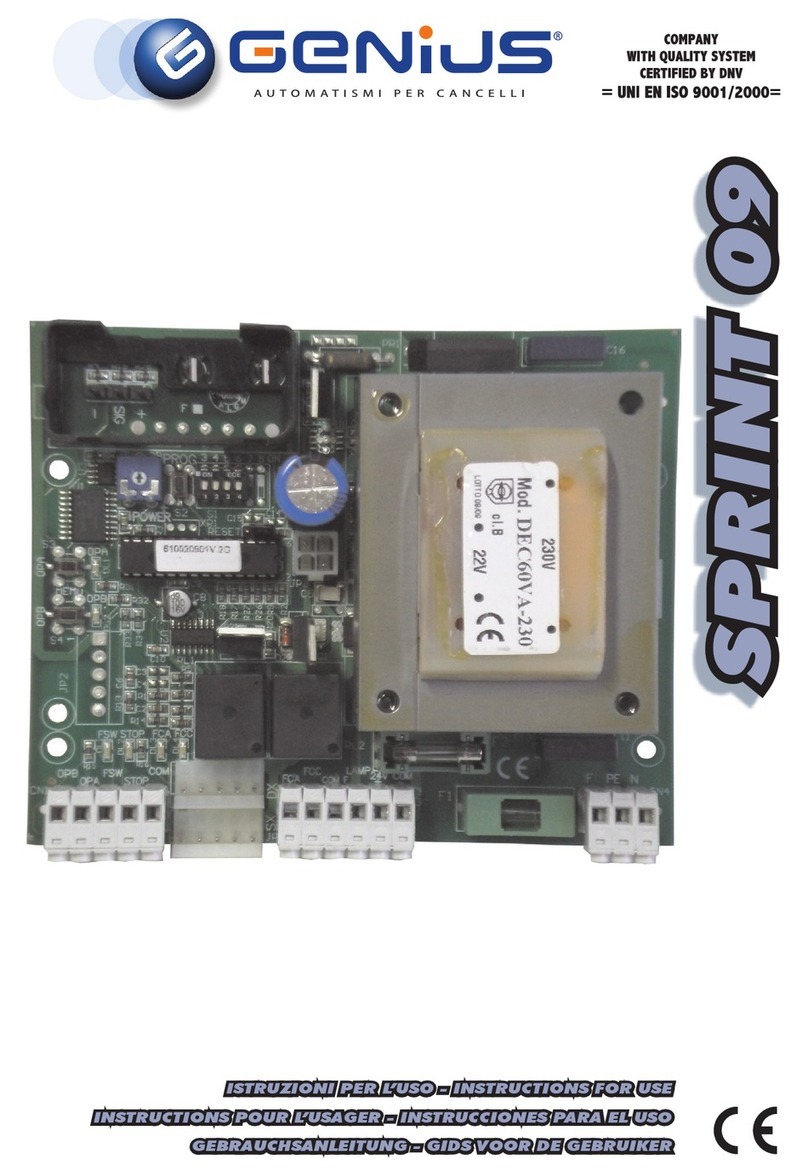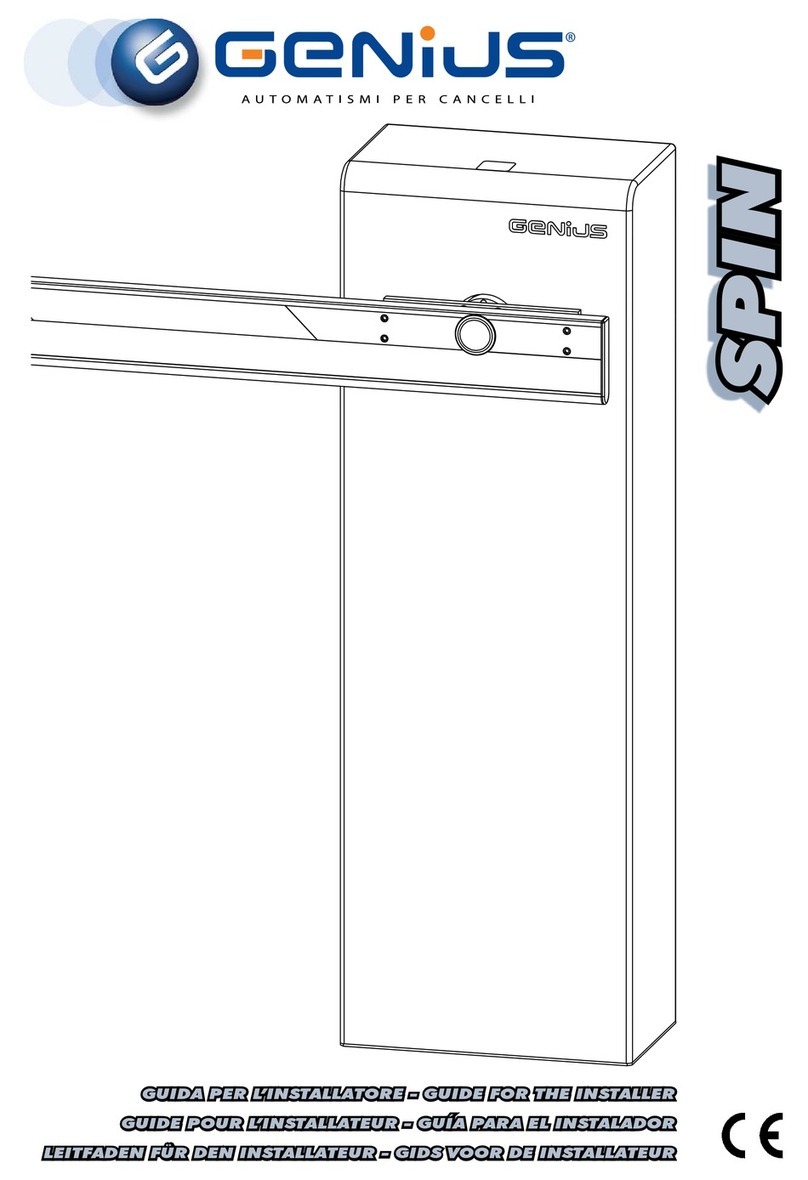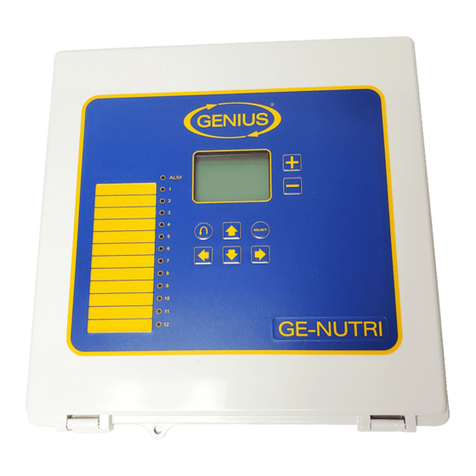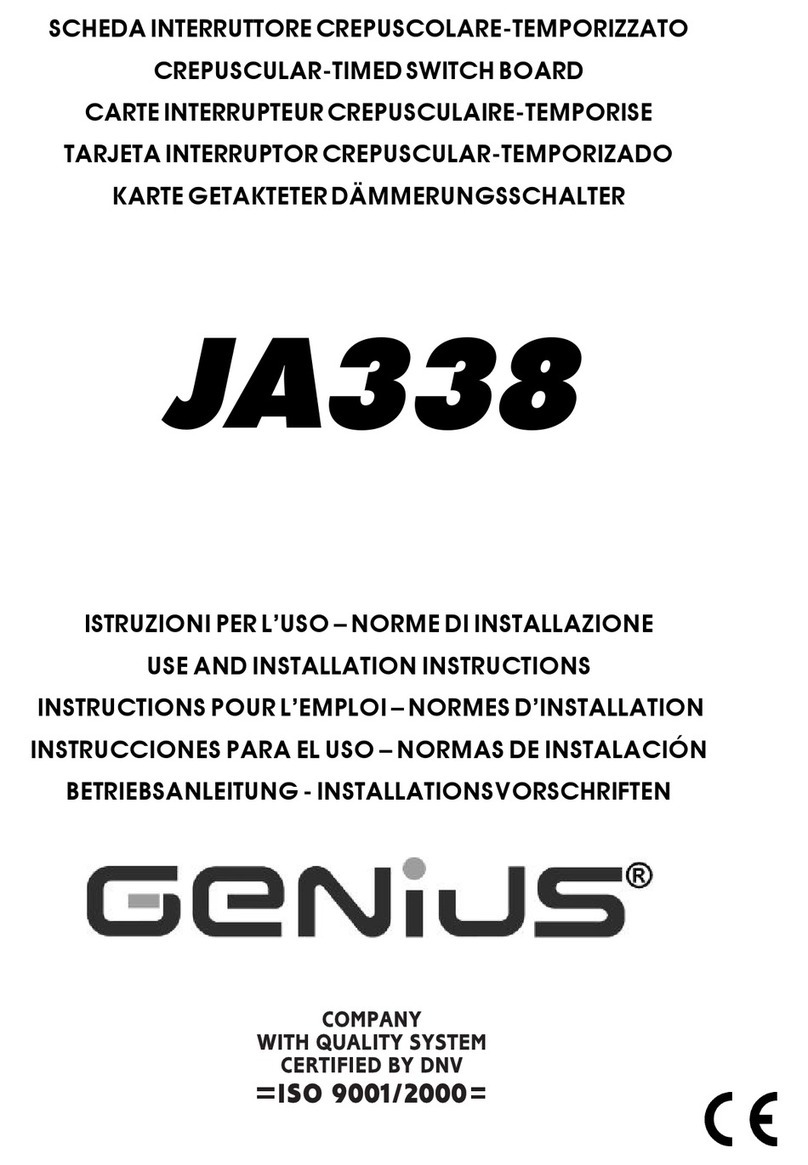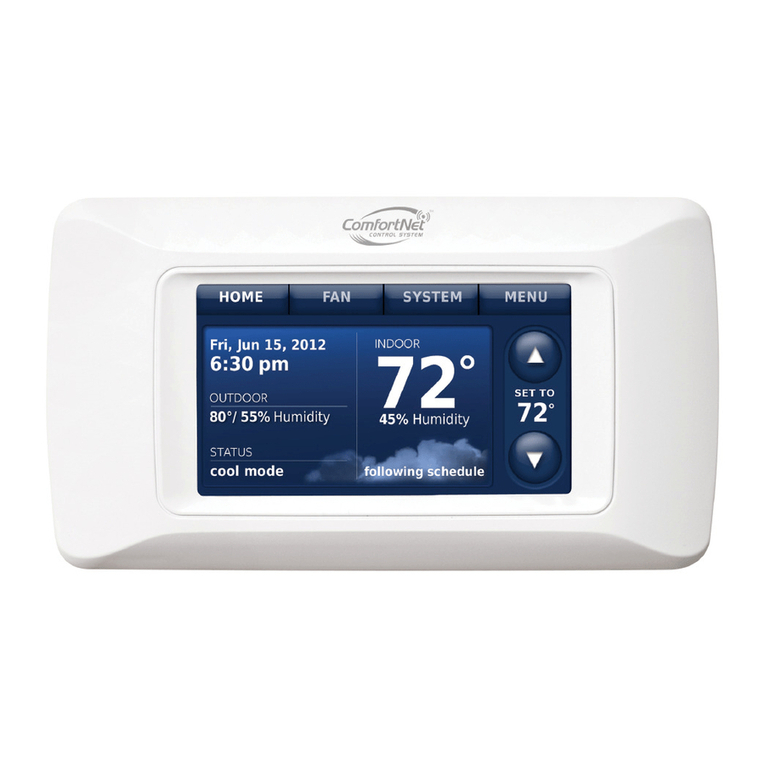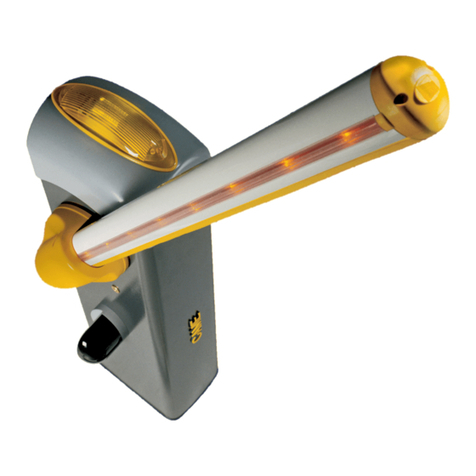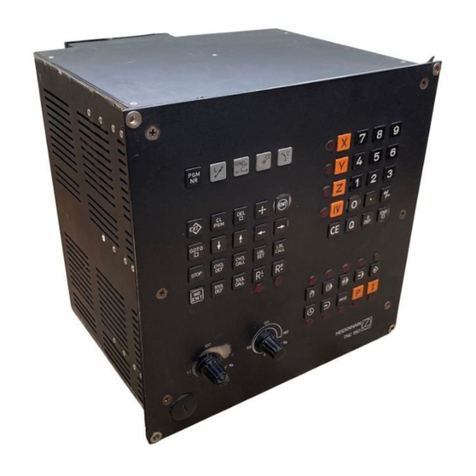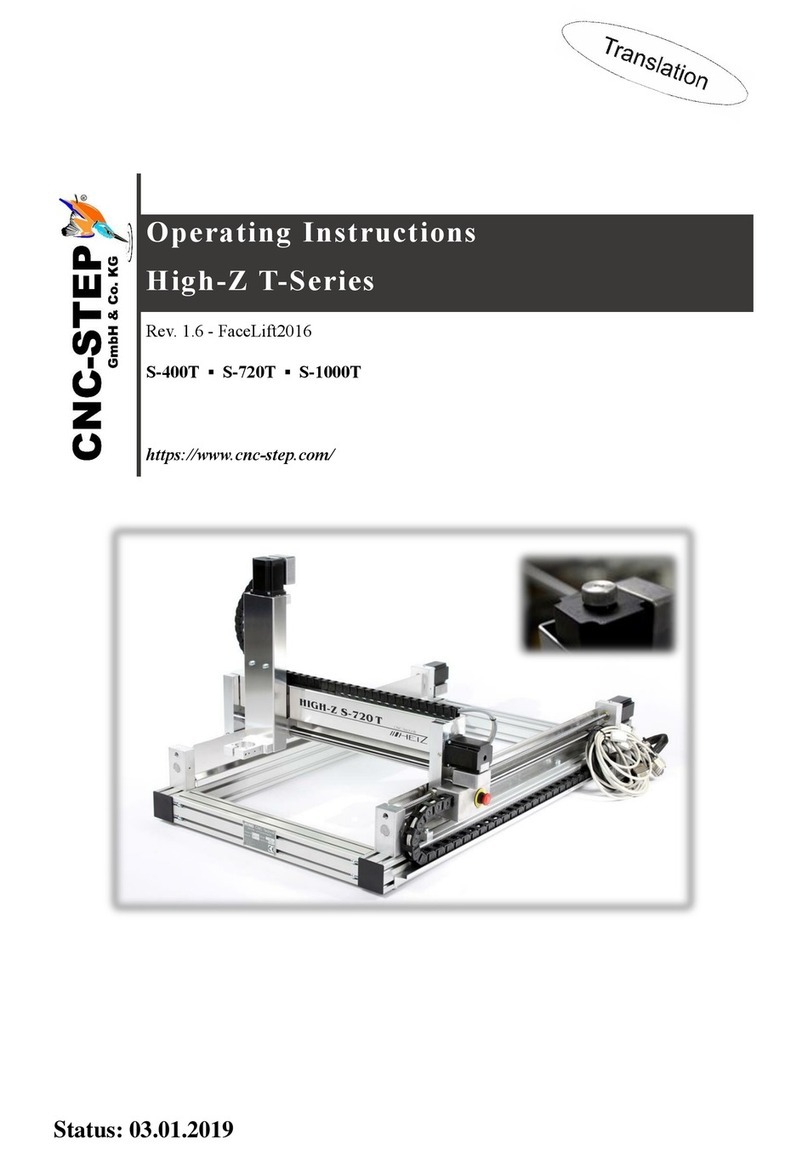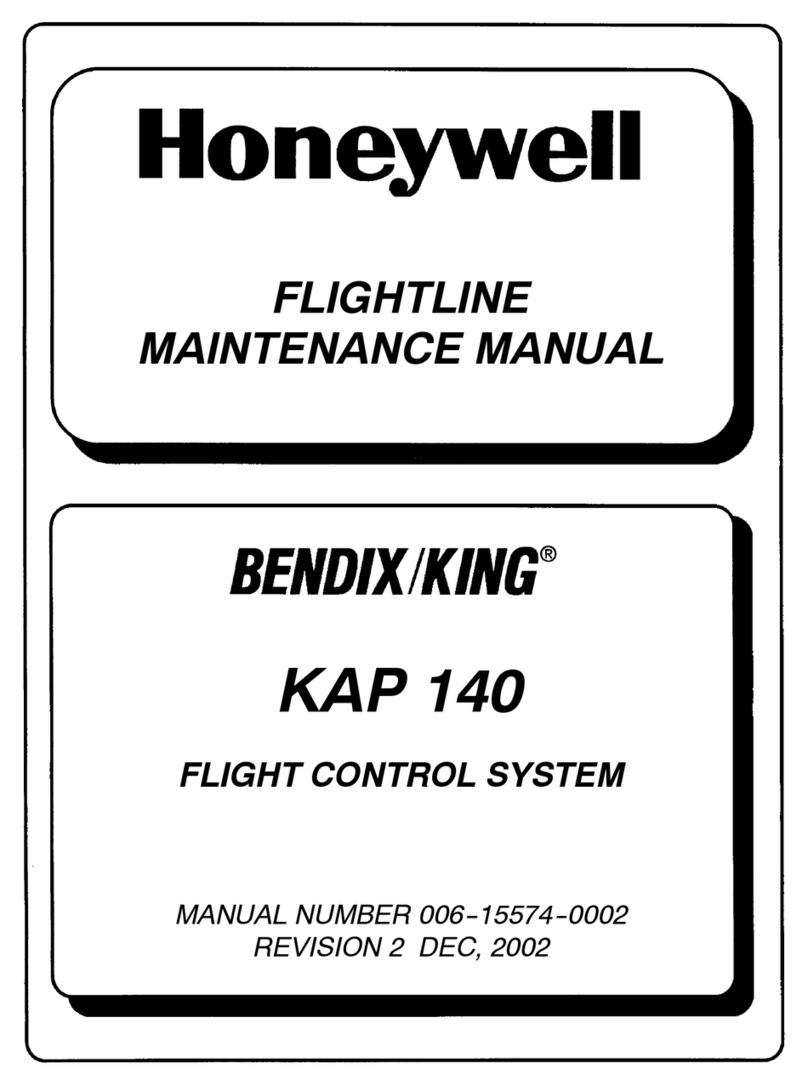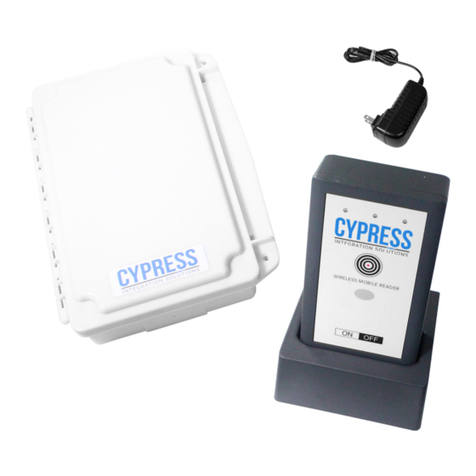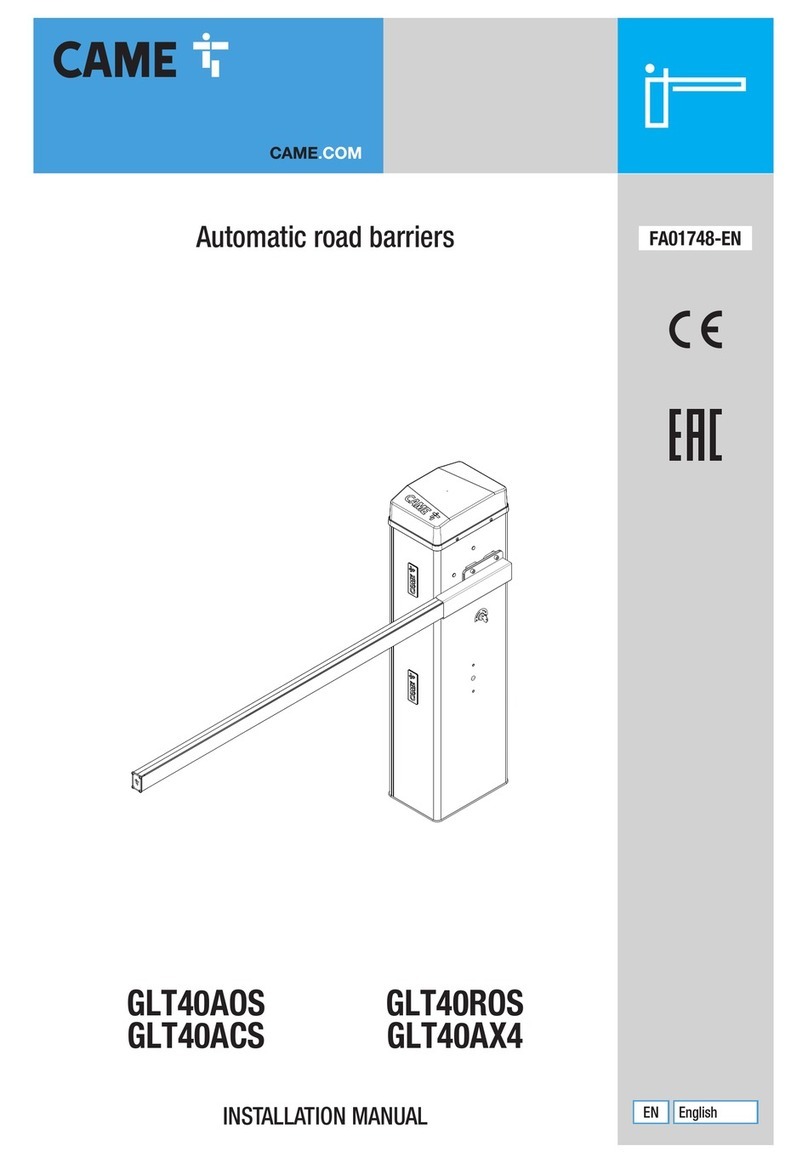L292.03 23-04-2002
ZVL292.03 / Mod. 23-04-2002
AM
433RC
via Padre Elzi, 32, 24050 - Grassobbio (BG)
Tel. +39 035 42 42 511 - Fax. +39 035 42 42 600
info@geniusg.com - www.geniusg.com
DIGITALE FUNKSTEUERUNG MIT DYNAMISCHEN CODES SERIE 433RC
MODELL DATUM
ART.-NR. SERIE
Dieses Produkt wurde in den Werkstätten der Herstellerfirma getestet
und geprüft. Bei der Installation sollten die anführten Angaben genau
befolgt werden.
Beschreibung
Das Funksteuerungssystem 433RC im "AM" Bereich besteht aus einem oder mehreren Sendern und aus einem
oder mehreren Empfängern, die gemäss den spezifischen Anforderungen der Anlage kombiniert werden.
Die Serie 433RC benutzt ein Kodifizierungssystem, dessen hohe Zuverlässigkeit durch die Verwendung von
dynamischen Codes gewährleistet ist. Bei jeder Übertragung ändert sich der Code gemäss eines Algorithmus,
und nur der Empfänger ist in der Lage, ihn zu erkennen und zu entscheiden, ob die Übertragung korrekt
im Vergleich mit dem Originalcode ist. Der Code wird über Funk auf dem Empfänger gespeichert. Der
Empfänger kann bis zu 300 verschiedene Codes speichern. Die Codes werden bei der Speicherung in
einen nichtflüchtigen Speicher übertragen.
Wichtig: Da sich bei jedem neuen Befehl der gesendete Code ändert, erwartet der Empfänger bei einer durch
eine Störung unterbrochenen Übertragung einen neuen Befehl mit einem anderen Code. Zu diesem Zweck
muss die Taste des Senders losgelassen und wieder gedrückt werden.
Anwendungsmöglichkeiten
Die Funksteuerung 433RC ermöglicht die Fernbedienung elektrischer und elektronischer Geräte und
findet beste Anwendung bei der Steuerung automatischer Öffnungssysteme, Alarmsystemen und bei allen
Anlagen, bei denen die Inbetriebsetzung durch eine mittels hochzuverlässigen Geheimcode geschützte
Fernbedienung (ohne Drähte) verlangt wird.
Sender-Versionen
A252 Taschensender 2 Tasten
A254 Taschensender 4 Tasten
Empfänger-Versionen
A245 Empfängerkarte 10 Pin (2 Ausgänge: "open collector" + Relais) 2 Kanäle
JA228 Empfängerkarte 5 Pin (1 Ausgang: "open collector") 1 Kanal
Speichermodul
Herausnehmbar, verfügt über nicht flüchtigen EEPROM-Speicher, beinhaltet die Sendercodes und erlaubt
die Speicherung von 300 Codes (300 Kanaltasten). Die Codes verbleiben im Speicher auch in Abwesenheit
der Stromversorgung.
Installation Empfänger - Antenne
Mindest- und Höchstreichweite der Funksteuerungen:
Unter Reichweite versteht sich der nutzbare Betriebsabstand zwischen Sender und Empfänger, deren Antenne
im freien Raum installiert und gemessen wurde. Daher steht die Reichweite in unmittelbarem Zusammenhang
mit den technischen Eigenschaften des Systems (Leistung und Ansprechempfindlichkeit) und verändert sich
entsprechend dem Aufstellungsort. Um einen optimalen Betrieb der Funksteuerung zu gewährleisten,
sind die Installationsorte für den Empfänger und die Antenne sorgfältig auszuwählen. Die Installation von
zwei Empfängern, zwischen denen kein Mindestabstand von 1,5 m eingehalten wird, ist nicht möglich. Es
ist ratsam, den Empfänger in gebührendem Abstand zu Computersystemen, Alarmanlagen und anderen
möglichen Störungsquellen aufzustellen.
Antenne
Die Installation der Antenne ist von äusserster Wichtigkeit; nachdem sie mit dem Empfänger verbunden ist, stellt sie
den Empfangspunkt für die Funksteuerung dar. Bei ihrer Installation ist folgendes zu beachten:
- Die Empfängerkarte ist mit einer eigenen Antenne ausgestattet, die aus einem Stück Draht besteht,
der 170 mm lang ist.
- Alternativ kann eine passende Antenne verwendet werden, die mittels einem Koaxialkabel RG 58 (Impedanz 50)
mit einer maximalen Länge von 15 m an den Empfänger angeschlossen wird. Die Antenne wird im Freien am
höchsten und sichtbarsten Punkt von Metallstrukturen entfernt, positioniert.
Sender
Der Sender ist vorkodifiziert und besitzt einen integrierten Schaltkreis, der im Werk schon mit einer für jeden
Sender einzigartigen Identifikationsnummer vorprogrammiert worden ist; alle für die Kodifizierung notwendigen
Parameter befinden sich in diesem integrierten Schaltkreis (es wird kein äusserer Speicher benutzt); dies macht
den Verwaltungsmechanismus der Kodifizierung wesentlich zuverlässiger und gestaltet das System sicherer.
Der Sender verfügt über einen Selbstausschaltmechanismus, der nach 25 Sekunden fortlaufender Aktivierung
das Gerät ausschaltet (Batteriestromersparnis).
Empfänger
Achtung! Für die Stromversorgung ausschliesslich ein Sicherheitsspeisegerät verwenden. Die Verwen-
dung eines andersartigen Speisegerätes kann gefährlich sein.
Die Karte muss in angemessener Weise gegenüber den Teilen der Apparatur, in die sie eingebaut wird und
die sich unter Netzspannung befinden, isoliert werden.
Die Empfängerkarten verfügen über einen Molex-Steckverbinder und können daher direkt in die dafür
vorbereiteten Apparaturen eingesetzt werden.
Bei der Empfängerkarten-Version A245 ist der Kanal CH1 vom Typ "open collector" und der Kanal CH2 vom
Typ eines stromfreien gemeinsamen Einschaltglied-Kontaktes (Anschlussklemmen 1-2 Abb. 5a Detail "C1";
Kontakte 7-8 auf dem Molex-Steckverbinder).
Die beiden Kanäle sind mittels des Jumpers "S1" Abb. 5a wählbar. Den beiden Funktionen CH1-CH2 des
Empfängers kann einer von den (max.) vier Kanälen des Senders zugeordnet werden.
Das Funkempfangsteil besteht aus einem auf die Karte gelötetem RF-Modul "R1" mit 433MHz.
Die Empfängerkarten-Version JA228 verfügt über einen einzigen Ausgang des Typs "open collector" (Kontakt
3 des Molex-Steckverbinders, Abb. 5b). Dieser Ausgang kann von irgendeinem der Senderkanäle gesteuert
werden, wenn dieser zuvor im Empfänger gespeichert worden ist.
LED-Kontrollleuchten "L1" auf dem Empfänger:
Schnelles Blinken: Löschung eines einzelnen Benutzers
Langsames Blinken: Speicherung eines Benutzers
Dauerleuchtend: Speicher voll.
Funktionen
A. Speicherung eines Kanals
B. Löschung eines Kanals (mittels der zugeordneten Funksteuerung)
C. Totale Löschung des Benutzerspeichers
D. Speicherung weiterer Kanäle durch Funk (ohne Öffnen des Gehäuses, in dem der Empfänger
untergebracht ist).
Achtung! Vor der Speicherung des ersten Senders Speicher vorher vollkommen löschen.
A - Speicherung eines Kanals (Abb. 4a)
1) Die Taste "P2" MEMO gedrückt halten: Die LED "L1" blinkt langsam.
2) Den Sender auf dem zu speichernden Kanal aktivieren.
3) Die Taste "P2" MEMO solange gedrückt halten, bis die LED "L1" wieder zu blinken anfängt.
4) Die Taste loslassen: Die LED fährt mit dem Blinken fort.
5) Den Sender ein zweites Mal aktivieren (gleicher Sender, gleicher Kanal; falls es sich um einen anderen Kanal
oder um einen anderen Sender handeln sollte, wird die Speicherung ohne Erfolg beendet).
6 Ende der Speicherung: Die LED "L1" leuchtet für 2 Sekunden und zeigt somit an, dass die Speicherung
erfolgreich war.
• Die Speicherung eines schon gespeicherten Benutzers ist nicht möglich. In einem solchen Fall wird das
Blinken der LED während der Aktivierung der Funksteuerung (Punkt 2) unterbrochen. Nur nach Loslassen
der Taste "P2" MEMO tritt das Programm wieder in Funktion.
• Wenn nach der ersten Aktivierung der Funksteuerung nicht dessen zweite Aktivierung vorgenommen
wird, schaltet sich der Speichermodus automatisch nach 15 Sekunden ab, ohne dass der neue Code
des Benutzers gespeichert wurde.
• Wenn beim ersten Mal ein Kanal aktiviert wird, der noch nicht gespeichert worden ist, und beim zweiten
Mal wird ein anderer, schon gespeicherter Kanal aktiviert, wird das Speicherverfahren abgebrochen
(weil die beiden Codes nicht übereinstimmen) und der Kanal aktiviert, der bei der zweiten Übertragung
gewählt worden ist.
Anmerkung: Nachdem mit der zweiten Phase des Speicherverfahrens (Punkt 4) begonnen worden ist, muss
das Speicherverfahren bis zu Ende durchgeführt werden. Falls der Code nicht mehr gespeichert werden soll,
mindestens 15 Sekunden verstreichen lassen: Die LED hört mit dem Blinken auf und die Speicherung wird
nicht ausgeführt. Wenn der Speicher des Empfängers fast voll ist, kann die Suche des Benutzers maximal
1 Sekunde nach Erhalt des Befehls dauern.
B - Löschung eines Kanals (Abb. 4a)
1) Die Taste "P1" DELETE gedrückt halten: Die LED "L1" blinkt schnell.
2) Den Sender auf dem zu löschenden Kanal aktivieren.
3) Die LED leuchtet für 2 Sekunden und zeigt somit die erfolgte Löschung an.
Anmerkung: Falls der zu löschende Benutzer sich nicht im Speicher befindet, hört die LED mit dem Blinken
auf. Das Programm nimmt seinen normalen Ablauf nur nach Loslassen der Taste "P1" wieder auf. Falls die
Taste vor der Aktivierung der Funksteuerung losgelassen wird, wird der Modus sowohl beim Speicher- als auch
beim Löschungsverfahren sofort abgebrochen.
C - Totale Löschung des Benutzerspeichers (Abb. 4a)
1) Beide Tasten ("P1+P2") für mehr als 4 Sekunden gedrückt halten.
2) Die LED "L1" leuchtet während der gesamten Zeit der Löschung (zirka 8 Sekunden).
3) Die LED "L1" erlischt: Die Löschung wurde abgeschlossen.
D - Speicherung weiterer Kanäle über Funk (Abb. 4b)
• Die Speicherung kann über Funk aktiviert werden (ohne Öffnen des Gehäuses, in dem der Empfänger
untergebracht ist) falls der Jumper "J2" eingesetzt worden ist (Abb. 5).
1) Sicherstellen, ob der Jumper "J2" auf dem Empfänger eingesetzt ist.
2) Betätigen der Taste "MR" auf der Funksteuerung, bei der mindestens eine der Kanaltasten "A-B-C-D" schon
auf dem Empfänger gespeichert worden ist, wie in Abbildung "4b" angezeigt wird.
Anmerkung: Alle von der Funksteuerung erreichbaren Empfänger und die mindestens einen Kanal des
Senders gespeichert haben, aktivieren gleichzeitig den Summer "B1" (Abb. 5).
3) Zur Wahl des Empfängers, bei dem der neue Code gespeichert werden soll, eine der Kanaltasten des
Senders aktivieren. Die Empfänger, die nicht den Code dieser Taste besitzen, schalten sich ab und
geben dabei einen 5 Sekunden dauernden Bipton von sich. Die Empfänger, die stattdessen den Code
gespeichert haben, geben einen andersartigen, eine Sekunde dauernden Bipton von sich und begeben
sich in den "funkgesteuerten" Speichermodus.
4) Die vorher beim zu speichernden Sender gewählte Kanaltaste drücken. Bei erfolgter Speicherung gibt
der Empfänger 2, eine halbe Sekunde lang dauernde Biptöne von sich. Danach ist der Empfänger
bereit, einen anderen Code zu speichern.
5) Um den Modus zu beenden, 3 Sekunden ohne einen Code zu speichern verstreichen lassen. Der Empfänger
gibt einen 5 Sekunden dauernden "Bip"-Ton von sich und verlässt die Modalität.
• Wenn der Speicher voll ist, gibt der Summer zehn, schnell aufeinanderfolgende Biptöne von sich
und beendet automatisch den "funkgesteuerten" Speichermodus. Die LED "L1" leuchtet weiter.
Das Gleiche geschieht auch bei jedem Versuch sich bei vollem Speicher in den "funkgesteuerten"
Modus zu begeben.
TECHNISCHE DATEN
Empfänger
- Empfangsfrequenz .............................................................................................................................. 433.92 Mhz
- Frequenz des örtlichen Oszillators ...................................................................................................... 433.42 Mhz
- Emission des örtlichen Oszillators ............................................................................................. <-57dBm (<2nW)
- Antenneneingangsimpedanz .........................................................................................................................50 W
- Empfindlichkeit (für das gültige Eingangssignal) ............................................................................................ 1 µV
- Stromversorgung A245 (mittels Jumper J1 wählbar) ..................................................................12/24 V Ws-Gs
- Stromversorgung JA228 ...............................................................................................................12/24 V Ws-Gs
- Stromaufnahme bei ruhendem/angeregtem Relais ...............................................................................20/45 mA
- Höchste umschaltbare Leistung vom Relais mit ohmscher Belastung:
Last bei Wechselstrom/Gleichstrom .................................................................................................... 60VA/24W
- Höchstspannung .................................................................................................................................... 30Vac/dc
- Abfallverzögerung ........................................................................................................................................250 ms
- Betriebstemperatur ........................................................................................................................... - 20°…+60°C
- max. Ansprechzeit auf den Befehl ........................................................................................................1 Sekunde
- min. Ansprechzeit auf den Befehl ........................................................................................................30 ms zirka
Sender
- Trägerfrequenz ..................................................................................................................................... 433.92 Mhz
- Trägerfrequenztoleranz .............................................................................................................................± 75 Khz
- scheinbare Strahlungsleistung .....................................................................................-10…-7dBm (100-200µW)
- scheinbare Leistung der Oberwellenprodukte ........................................................................... <-54 dBm (4nW)
- Modulation .................................................................................................................................................AM/ASK
- modulierendes Signal ...................................................................................................................PCM, 1.2 ms/bit
- Stromversorgung (Alkaline GP23A) ..................................................................................................... 12V ± 10%
- Stromaufnahme ............................................................................................................................................30 mA
- Betriebstemperatur ........................................................................................................................... - 10°…+55°C
- Anzahl der Codekombinationsmöglichkeiten (eingebauter Teil, 28 Bit) ................................ über 268 Millionen
- Anzahl aller Kombinationsmöglichkeiten (66 Bit) .............................................................................................. 266
- max. Anzahl der Kanäle ........................................................................................................................................4
- Selbstausschaltung .................................................................................................................nach 25 Sekunden
